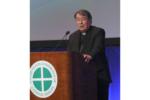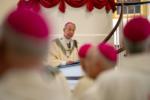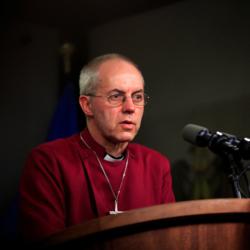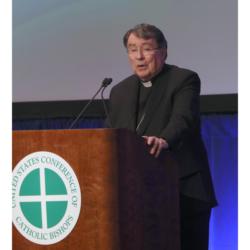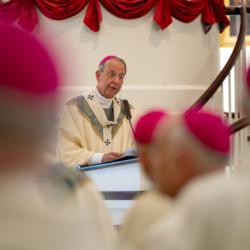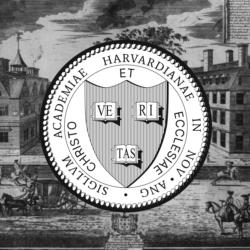'All metropolitans are archbishops, but not all archbishops are metropolitans'
With the arrival of our new archbishop, you will see and hear the word metropolitan used either as an adjective or as a noun.
On Oct. 31, 2024, once seated in the cathedra or bishop's chair in the Metropolitan Cathedral of the Holy Cross, he will be the metropolitan (noun) or metropolitan (adjective) archbishop.
This article will look at the word as we use it in the Church, and specifically in the Latin Rite of the Roman Catholic Church. The secular world also uses it usually to describe some geographically defined area often identified by a major city and its surrounding municipalities.
The word has a nice origin meaning: "mother city." The principal city is seen as having given birth to its surrounding areas, whether ecclesiastical or civic.
The Church in New England had a very small, microscopic presence, even when Boston was made a diocese in 1808. Until that time, the whole of the United States, from the Allegheny mountains east to the Atlantic and from the Carolinas north to the border with Canada, was the single Diocese of Baltimore. The only parish in the whole of New England -- the territory of the new diocese -- was the Cathedral Parish of the Holy Cross.
From 1808 until 1875 -- when Boston was named a Metropolitan See, there was steady and some dramatic growth in both civic and Catholic populations. The Catholic growth was evident by the creation of new dioceses: Hartford -- including all of Connecticut and Rhode Island in 1843; 10 years later, in 1853, the Diocese of Burlington, including all of the Green Mountain State, and that of Portland, comprising all of Maine and New Hampshire.
From 1853 to 1870, the Diocese of Boston was the whole of the Bay State. In 1870, the five western most counties of the Commonwealth -- Berkshire, Franklin, Hamden, Hampshire, and Worcester were constituted the Diocese of Springfield.
In 1872, the Diocese of Providence was created. Boston's Bishop Williams thought that the state of Rhode Island would not be large enough, i.e., Catholic population to support the diocese, so he gave to the new Diocese of Providence, Cape Cod and the Islands.
In 1875, the Holy See, recognizing the rapid growth of the Church in the United States, created on one day four new Metropolitan Sees. Boston was one of the quadruplets. Together with Milwaukee, Philadelphia of the Latins, and Sante Fe in North America, Boston will celebrate next year the sesquicentennial or 150th anniversary of its metropolitan status. Among the quadruplets is Philadelphia, which, like Boston, had been made a diocese on April 8, 1808.
The new Metropolitan See of Boston was to be headed by the new archbishop, John Joseph Williams, who had been the See's fourth bishop since 1866.
In 1875, the new metropolitan was responsible for all of New England, with its Suffragan Sees at Burlington, Hartford, Providence, Portland, Springfield. The first new Suffragan See added was Manchester, when, in 1884, the Granite State was separated from the Pine Tree State and its Diocese of Portland. More suffragans were added with the creation of the Diocese of Fall River in 1904, with the Cape and the Islands separated from Providence; and of the Diocese of Worcester in 1950, with the separation of the Commonwealth's central Worcester county from Springfield.
The last change that affected the Metropolitan See of Boston was in 1953 when Venerable Pope Pius XII created two new dioceses in Connecticut -- Bridgeport and Norwich, with territory taken from the Diocese of Hartford, and made Hartford a Metropolitan See with Providence and the Nutmeg State's two new dioceses as its suffragans.
So just what responsibilities does Archbishop Henning have for his Suffragan Sees.
First, keep in mind that his primary responsibility is as bishop of the Archdiocese of Boston.
Next, he has some limited responsibility in the Suffragan Sees. Mostly, he facilitates the communication between and among the bishops of his province -- Maine, Massachusetts, New Hampshire, and Vermont.
Over the years, as the office of metropolitan developed, the metropolitan archbishops acquired substantial power over and within their Suffragan Sees. Principal among these was vigilance over the suffragans and acting when problems might arise. He could interfere in the governance of the suffragans and, in the days when communications were limited, he could almost be a "little pope."
Much of that has disappeared from the job description of the metropolitan. And metropolitans today are probably grateful for it. Researching this article, I came across a gem and a right that metropolitans used to enjoy: they could raise funds for their Metropolitan See in the Suffragan Sees without the consent of the diocesan bishop! There are probably not a few metropolitans who might like this right restored! Not only an annual appeal in your own Metropolitan See, but one in each of the suffragans!
The Code of Canon Law succinctly lists the metropolitan's job.
Metropolitan "fun facts"
-- A metropolitan is defined by having suffragans, unless he has none. There are two such situations in the world -- the metropolitan Archdiocese of St. Boniface, Manitoba, Canada; and Udine, in northern Italy.
-- The Metropolitan See with the largest number of suffragans in the world is Rome. There are 18 Suffragan Sees, including suburbicarian sees (only Rome has those); suffragan dioceses and archdioceses; and a suffragan territorial abbey, the famous Benedictine Territorial Abbey of Monte Casino.
--Around the globe, there are many metropolitans with only one or two suffragans.
--In the United States, St. Paul and Minneapolis has the largest number of Suffragan Sees with nine, the states of Minnesota, and North and South Dakota comprise the territory of the province.
--There are two Metropolitan Sees in the United States that have one suffragan each. The Archdiocese of Washington, D.C. has its sole suffragan at the Diocese of St. Thomas in the United States Virgin Islands; and the Archdiocese of Anchorage-Juneau, has Fairbanks as its sole suffragan. The state of Alaska is the largest US metropolitan province geographically, with 665, 384 square miles. It dwarfs Texas with its 268,596 square miles, but Texas has two Metropolitan Sees: San Antonio with seven suffragans, and Galveston-Houston with six.
Metropolitans
Can. 435: A metropolitan, who is the archbishop of his diocese, presides over an ecclesiastical province. The office of metropolitan is joined with an episcopal see determined or approved by the Roman Pontiff.
Can. 436
1. In the suffragan dioceses, a metropolitan is competent:
to exercise vigilance so that the faith and ecclesiastical discipline are observed carefully and to inform the Roman Pontiff of abuses, if there are any;
to conduct a canonical visitation for a cause previously approved by the Apostolic See if a suffragan has neglected it;
to designate a diocesan administrator according to the norm of cann. 421, 2, and 425, 3.
2. Where circumstances demand it, the Apostolic See can endow a metropolitan with special functions and power to be determined in particular law.
3. The metropolitan has no other power of governance in the suffragan dioceses. He can perform sacred functions, however, as if he were a bishop in his own diocese in all churches, but he is first to inform the diocesan bishop if the church is the cathedral.
Can. 437
1. Within three months from the reception of episcopal consecration or if he has already been consecrated, from the canonical provision, a metropolitan is obliged to request the pallium from the Roman Pontiff either personally or through a proxy. The pallium signifies the power which the metropolitan, in communion with the Roman Church, has by law in his own province.
2. A metropolitan can use the pallium according to the norm of liturgical laws within any church of the ecclesiastical province over which he presides, but not outside it, even if the diocesan bishop gives his assent.
3. A metropolitan needs a new pallium if he is transferred to another Metropolitan See.




